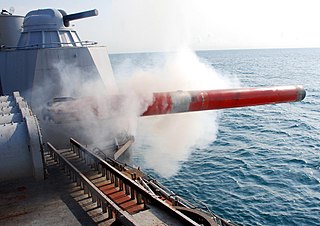
The Indian Navy is the maritime branch of the Indian Armed Forces. The President of India is the Supreme Commander of the Indian Navy. The Chief of Naval Staff, a four-star admiral, commands the navy. As a blue-water navy, it operates significantly in the Persian Gulf Region, the Horn of Africa, the Strait of Malacca, and routinely conducts anti-piracy operations and partners with other navies in the region. It also conducts routine two to three month-long deployments in the South and East China seas as well as in the western Mediterranean sea simultaneously.

The Scorpène-class submarines are a class of diesel-electric attack submarines jointly developed by the French Naval Group and the Spanish company Navantia. It features diesel propulsion and an additional air-independent propulsion (AIP). It is now marketed as the Scorpène 2000.

INS Shishumar (S44) is the lead vessel of the Shishumar class of diesel-electric submarines of the Indian Navy. She was commissioned on 22 September 1986 under Commander P M Bhate.
INS Abhay (P33) ("Fearless") is the lead ship of her class of anti-submarine warfare corvettes, which are in service with the Indian Navy.
UMS Minye Theinkhathu (71) is a Sindhughosh (Kilo)-class submarine owned by the Myanmar Navy. It is the first of two submarines procured by the country's navy, followed by the UMS Minye Kyaw Htin. Before being acquired by Myanmar, it served in the Indian Navy as INS Sindhuvir (S58).
INS Sindhuratna (S59) is a Sindhughosh-class diesel-electric submarine of the Indian Navy.
INS Sindhukesari (S60) is a Sindhughosh-class diesel-electric submarine of the Indian Navy.
INS Shankush (S45) is a Shishumar-class diesel-electric submarine of the Indian Navy.
INS Shalki (S46) is a Shishumar-class diesel-electric submarine of the Indian Navy. The submarine was the first ever submarine to be built in India.

The Kalvari-class submarines, formally classified as the Project-75 submarines (P-75), is a class of diesel-electric attack submarines operated by the Indian Navy (IN). Currently being constructed by a syndicate of French and Indian shipyards, namely, Naval Group and Mazagon Dock Limited (MDL) respectively, the class is an export derivative of the French-origin Scorpène-class submarine, originally designed by Naval Group.
INS Kalvari (S23) was the lead vessel of the Kalvari class of diesel-electric submarines of the Indian Navy. It was the first ever submarine inducted into service by the Indian Navy. The submarine was laid down on 27 December 1966 as Foxtrot-class submarine B-51 of the Soviet Navy by Novo-Admiralty at Galerniy Island, Leningrad.
INS Vela (S40) was the lead ship of four diesel-electric Vela-class submarines of the Indian Navy. The submarine was commissioned on 31 August 1973 in Riga, Latvian SSR. Along with her sister ship Vagli, she spent almost 10 years undergoing a protracted refit by Hindustan Shipyard. After 37 years of service, the submarine was decommissioned on 25 June 2010. The submarine was claimed by the Eastern Naval Command to be the oldest operational submarine in the world at the time of her decommissioning.
INS Vagir (S41) was a Vela-class diesel-electric submarine of the Indian Navy.

The Torpedo Advanced Light (TAL) Shyena is the first indigenous advanced lightweight anti-submarine torpedo of India, developed by the Naval Science and Technological Laboratory (NSTL) of the Defence Research and Development Organisation (DRDO) for the Indian Navy. The lightweight torpedo can be launched by ships, submarines, helicopters and previously the now retired Ilyushin Il-38, named after the divine hawk identified with Agni.

The Anti-Submarine Warfare Shallow Water Craft (ASW-SWC) corvettes, are a class of anti-submarine warfare (ASW) vessels currently being built for the Indian Navy, by Cochin Shipyard (CSL) and Garden Reach Shipbuilders & Engineers (GRSE). They were conceived as a replacement to the ageing Abhay-class corvettes of the Indian Navy, and are designed to undertake ASW duties – including subsurface surveillance in littoral waters, search-and-attack unit (SAU) missions and coordinated anti-submarine warfare operations with naval aircraft. They were also designed to provide secondary duties – including defense against intruding aircraft, minelaying and search-and-rescue (SAR).

The Indian Navy has been focusing on developing indigenous platforms, systems, sensors and weapons as part of the nation's modernisation and expansion of its maritime forces. As of November 2023, the Indian Navy has 67 vessels of various types under construction including destroyers; frigates; corvettes; conventional-powered and nuclear-powered submarines and various other ship, and plans to build a strong navy of 200 vessels and 500 aircraft by 2050. According to Chief of Naval Staff's statement in December 2020, India has transformed from a buyer's navy to a builder's navy.

Project-75 (India), simply referred to as the P-75(I) program, is a military acquisition initiative affiliated to India's Ministry of Defence (MoD), aimed at the planned procurement of diesel-electric submarines for the Indian Navy (IN). Originally conceived in 1997, the initiative's objective has been to procure a class of six conventionally-powered attack submarines for the Indian Navy Submarine Arm, as a replacement for the force's Sindhughosh-class submarines.

The Varunastra is an Indian advanced autonomous heavyweight anti-submarine torpedo, developed by Naval Science and Technological Laboratory (NSTL) of the Defence Research and Development Organisation (DRDO) for the Indian Navy. It is named after a legendary weapon created by the Hindu god of the oceans, Varuna.

INS Vela (S24) is the fourth submarine of the first batch of six Kalvari-class submarines for the Indian Navy. It is a diesel-electric attack submarine based on the Scorpène class, designed by French naval defence and energy group DCNS and manufactured by Mazagon Dock Limited, an Indian shipyard in Mumbai. The first cutting of steel for the submarine began on 14 July 2009, and the ship was launched on 6 May 2019.









